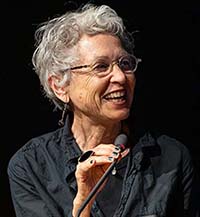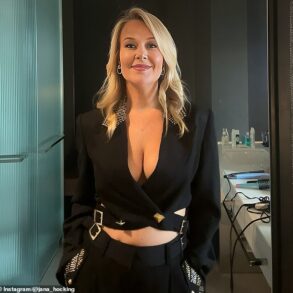
UC San Diego Professor Lisa Cartwright emcees the discussion about the “Three Lives” show, which she co-curated. (Photo by Hana Tobias)
“The ‘Three Lives’ project was, for me, a very important one. We are introducing three women oceanographers, two of them queer and one of them Black, who were first in the field: Easter Ellen Cupp, the first woman Ph.D. in oceanography [at UC San Diego’s Scripps Institution of Oceanography, who became a high school science teacher after being passed over for a job in the field]; Anita B. Smith Hall, founder of the first marine biology program at a historically black college [Hampton University]; and June Pattullo [the first woman to receive a Ph.D. in physical oceanography who later worked under geophysicist Walter Munk]. It was interesting to find there was nothing about any of these women in the history outside of a few items in the archives, and that Anita Smith Hall was denied the opportunity to defend her dissertation despite having written it.”
— Lisa Cartwright, Curator and UC San Diego Professor of Visual Arts
“It was really interesting piecing together the available photography and trying to get a clear sense of who these women were. It was only really when I started drawing them that I was completely startled by their personalities that emerged in the drawings. It happened with every single one of them, which doesn’t always happen when I’m drawing people. I just started drawing them, and they literally appeared and wanted to be articulated and rendered and present. When I see these images now all over the place, it’s exciting because I think that they are women [who] were invisible and now they’re highly visible, and it’s through the medium of drawing.”
— Amy Adler, Artist
“[My piece] brings the element that is essential to all these women, which is water. I made an abstract seascape of the San Diego ocean to bring it into the space to speak to what’s lost beneath the surface. The picture is an ashen gray-black, and because it’s an abstraction, it takes time to understand what you’re looking at, but it’s essentially the shore breaking across the ocean, inverted vertically. I was thinking about that, the water, and just literally how archives are lost and the idea of just how astonishing that is.”
— Chanell Stone, Artist
This post was originally published on this site be sure to check out more of their content







